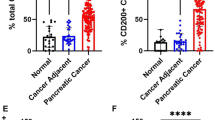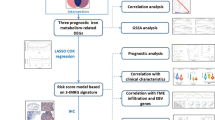Abstract
To study the expression of programmed death-ligand 1 (PD-L1), and its effects on CD8+ tumor infiltrating lymphocytes (TILs) and tumor associated macrophages (TAMs) in human laryngeal squamous cell carcinoma. Sixty-nine patients with laryngeal carcinoma and 10 with vocal cord leukoplakia received tumor resection at Neck Surgery Department in the Second Affiliation Hospital of Jilin University (Changchun, Jilin) from Jan. 2010 to Dec. 2015. The expressions of PD-L1, CD8, CD16 and CD206 in laryngeal carcinoma, paracancerous and vocal cord leukoplakia tissues were detected with immunohistochemistry. The associations between PD-L1 expression and clinicopathologic features, expression of TAMs and CD8+ T cell infiltration were analyzed. Expression of PD-L1 is significantly higher in laryngeal carcinoma than in paracancerous or leukoplakia tissue. The expression of PD-L1 is closely associated with stage of laryngeal cancer, histological differentiation and neck lymphatic metastasis. PD-L1 expression is negatively correlated with the number of CD8+ TILs and CD16+ cells (M1 type TAMs), while is positively associated with CD206+ (M2 type TAMs). PD-L1 is highly expressed in the laryngeal cancer with the tumor microenvironment immunosuppression.



Similar content being viewed by others
References
Ferris RL, Whiteside TL, Ferrone S (2006) Immune escape associated with functional defects in antigen-processing machinery in head and neck cancer. Clin Cancer Res 12(13):3890–3895
Zandberg DP, Strome SE (2014) The role of the PD-L1:PD-1 pathway in squamous cell carcinoma of the head and neck. Oral Oncol 50(7):627–632
Jinushi M, Komohara Y (2015) Tumor-associated macrophages as an emerging target against tumors: creating a new path from bench to bedside. Biochim Biophys Acta 1855(2):123–130
Lee YH, Martin-Orozco N, Zheng P, Li J, Zhang P, Tan H, Park HJ, Jeong M, Chang SH, Kim BS, Xiong W, Zang W, Guo L, Liu Y, Dong ZJ, Overwijk WW, Hwu P, Yi Q, Kwak L, Yang Z, Mak TW, Li W, Radvanyi LG, Ni L, Liu D, Dong C (2017) Inhibition of the B7-H3 immune checkpoint limits tumor growth by enhancing cytotoxic lymphocyte function. Cell Res 27:1034–1045
Liu Z, Zhao Y, Fang J, Cui R, Xiao Y et al (2017) SHP2 negatively regulates HLA-ABC and PD-L1 expression via STAT1 phosphorylation in prostate cancer cells. Oncotarget
Fife BT, Pauken KE, Eagar TN, Obu T, Wu J, Tang Q, Azuma M, Krummel MF, Bluestone JA (2009) Interactions between PD-1 and PD-L1 promote tolerance by blocking the TCR-induced stop signal. Nat Immunol 10(11):1185–1192
Zhang L, Li Z, Ding G, La X, Yang P et al (2017) GRP78 plays an integral role in tumor cell inflammation-related migration induced by M2 macrophages. Cell Signal 37:136–148
Chen J, Li G, Meng H, Fan Y, Song Y, Wang S, Zhu F, Guo C, Zhang L, Shi Y (2012) Upregulation of B7-H1 expression is associated with macrophage infiltration in hepatocellular carcinomas. Cancer Immunol Immunother 61(1):101–108
Gordon SR, Maute RL, Dulken BW, Hutter G, George BM, McCracken MN, Gupta R, Tsai JM, Sinha R, Corey D, Ring AM, Connolly AJ, Weissman IL (2017) PD-1 expression by tumour-associated macrophages inhibits phagocytosis and tumour immunity. Nature 545(7655):495–499
Francisco LM, Salinas VH, Brown KE, Vanguri VK, Freeman GJ, Kuchroo VK, Sharpe AH (2009) PD-L1 regulates the development, maintenance, and function of induced regulatory T cells. J Exp Med 206(13):3015–3029
Yvorel V, Patoir A, Casteillo F, Tissot C, Fournel P, Stachowicz ML, Karpathiou G, Tiffet O, Péoc’h M, Forest F (2017) PD-L1 expression in pleomorphic, spindle cell and giant cell carcinoma of the lung is related to TTF-1, p40 expression and might indicate a worse prognosis. PLoS One 12(7):e0180346
Roper E, Lum T, Palme CE, Ashford B, Ch'ng S, Ranson M, Boyer M, Clark J, Gupta R (2017) PD-L1 expression predicts longer disease free survival in high risk head and neck cutaneous squamous cell carcinoma. Pathology 49:499–505
Milstein O, Hagin D, Lask A, Reich-Zeliger S, Shezen E, Ophir E, Eidelstein Y, Afik R, Antebi YE, Dustin ML, Reisner Y (2011) CTLs respond with activation and granule secretion when serving as targets for T-cell recognition. Blood 117(3):1042–1052
Mischinger J, Comperat E, Schwentner C, Stenzl A, Gakis G (2015) Inflammation and Cancer: what can we therapeutically expect from checkpoint inhibitors? Curr Urol Rep 16(9):59
Ager CR, Reilley MJ, Nicholas C, Bartkowiak T, Jaiswal AR, Curran MA (2017) Intratumoral STING activation with T cell checkpoint modulation generates systemic antitumor immunity. Cancer Immunol Res 5:676–684
Fujii N, Shomori K, Shiomi T, Nakabayashi M, Takeda C, Ryoke K, Ito H (2012) Cancer-associated fibroblasts and CD163-positive macrophages in oral squamous cell carcinoma: their clinicopathological and prognostic significance. J Oral Pathol Med 41(6):444–451
Chen C, Qu QX, Shen Y, Mu CY, Zhu YB, Zhang XG, Huang JA (2012) Induced expression of B7-H4 on the surface of lung cancer cell by the tumor-associated macrophages: a potential mechanism of immune escape. Cancer Lett 317(1):99–105
Kuang DM, Zhao Q, Peng C, Xu J, Zhang JP, Wu C, Zheng L (2009) Activated monocytes in peritumoral stroma of hepatocellular carcinoma foster immune privilege and disease progression through PD-L1. J Exp Med 206(6):1327–1337
Kang FB, Wang L, Li D, Zhang YG, Sun DX (2015) Hepatocellular carcinomas promote tumor-associated macrophage M2-polarization via increased B7-H3 expression. Oncol Rep 33(1):274–282
Chen W, Jiang J, Xia W, Huang J (2017) Tumor-related exosomes contribute to tumor-promoting microenvironment: an immunological perspective. J Immunol Res 2017:1073947
Acknowledgements
Thanks to Dr. Xueshibojie Liu and Yuanzhang Zu for their contribution to the work!
Funding
This work is supported by the National Natural Science Youth Foundation of China (81502348), the National Natural Science Foundation of China (81572653), International Cooperation Project from Science and Technology Department of Jilin Province (20180414054GH) and the Natural Science Foundation of Jilin Province (20160101039JC).
Author information
Authors and Affiliations
Corresponding author
Ethics declarations
Conflict of Interest Statements
All the authors declare that they have no conflict of interest.
Rights and permissions
About this article
Cite this article
Yu, D., Cheng, J., Xue, K. et al. Expression of Programmed Death-Ligand 1 in Laryngeal Carcinoma and its Effects on Immune Cell Subgroup Infiltration. Pathol. Oncol. Res. 25, 1437–1443 (2019). https://doi.org/10.1007/s12253-018-0501-x
Received:
Accepted:
Published:
Issue Date:
DOI: https://doi.org/10.1007/s12253-018-0501-x




